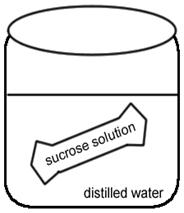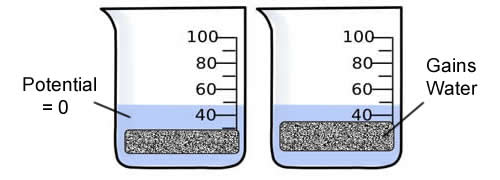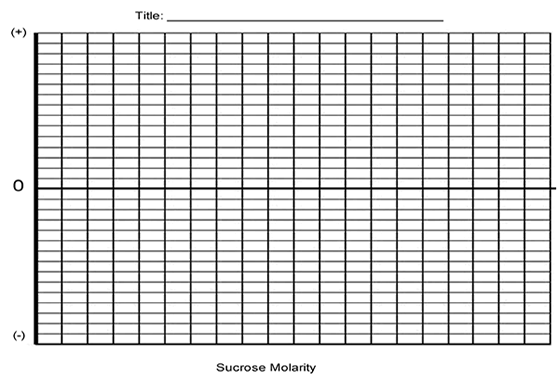Why Did You Calculate The Percent Change In Mass Rather Than Simply Using The Change In Mass?
Name:_____________________________________________________
Investigation: Osmosis and Water Potential
 In this lab, you volition detect the process of osmosis and improvidence. You volition too acquire how to calculate h2o potential. If you are non familiar with these concepts, brand sure that you take looked them upward in your textbook. If you don't know what these terms hateful, this lab is not going to brand sense to you.
In this lab, you volition detect the process of osmosis and improvidence. You volition too acquire how to calculate h2o potential. If you are non familiar with these concepts, brand sure that you take looked them upward in your textbook. If you don't know what these terms hateful, this lab is not going to brand sense to you.
OBJECTIVES
- Investigate the processes of osmosis in a model of a membrane organization
- Investigate the effect of solute concentration on water potential as it relates to living institute tissues
Exercise 1 - Osmosis Across a Membrane
1. Obtain half-dozen strips of dialysis tubing and tie an knot in 1 end of each.
ii. Pour approximately xv-xx ml of each of the following solutions into separate bags.
| Distilled H2o | 0.4 M sucrose | 0.eight Thousand sucrose |
| 0.2 Thousand sucrose | 0.6 M sucrose | i.0 M sucrose |
3. Remove most of the air from the bag (but exit a trivial fleck of infinite) and necktie the baggie.
4. Absorb the bags to remove whatever carbohydrate that may have spilled, cheque the bags for leaks.
5. Record the mass of each baggie in the information tabular array.
vi. Make full six beakers with plenty distilled water to cover your bags. Place a pocketbook in each one (keep runway of which bag is in which beaker)
7. Let the purse sit down for 20-30 minutes. -------- While this is running, set up potatoes for exercise 3.
Predict what you think will happen during the experiment. (Think about which bags will lose water and which will gain h2o.)
8. After 20-30 minutes, remove the baggies from the h2o, and carefully blot dry out and record the final weight.
ix. To calculate: percent change in mass= (concluding mass-initial mass)/ initial mass. Then multiply answer by 100.
| Contents in Bag | Initial Mass | Concluding Mass | Mass Deviation | Time in Chalice | % Modify in Mass |
| Distilled Water | |||||
| 0.2 K | |||||
| 0.four M | |||||
| 0.half-dozen Chiliad | |||||
| 0.8 1000 | |||||
| one.0 M |
11. Graph the results for your individual data that shows the human relationship betwixt %change in mass and the molarity of the solution. The independent variable is on the X axis, and the dependent variable is on the Y axis

ANALYSIS
1. Describe the relationship between the modify in mass and the molarity of the sucrose in the dialysis tube.
Based on scientific principles, did you observe what you expected? If not, suggest a reason or possible errors in ready-upward or data gathering.
ii. Why did you lot calculate the percent modify in mass rather than simply using the change in mass?
3. Predict what would happen to the mass of each bag in this experiment if all the bags were placed in 0.4 M sucrose solution instead of distilled water. Explain your response.
4. A dialysis bag is filled with distilled water and so placed in a sucrose solution. The handbag's initial mass is xx m, and its final mass is xviii one thousand. Calculate the percent change of mass, showing your calculations.
Practise 2 - Determining the Water Potential of Potato Cells
In animal cells, the motion of h2o into and out of the cell is influenced by the relative concentration of solute on either side of the cell membrane. If water moves out of the cell, the cell will compress. If water moves into the cell, the prison cell may smashing or even burst. In institute cells, the presence of a cell wall prevents the cells from bursting, simply force per unit area does somewhen build upwardly within the prison cell and affects the process of osmosis. When the pressure inside the cell becomes large enough, no additional water will accumulate in the prison cell even. And so movement of water through the constitute tissue cannot exist predicted simply through knowing the relative solute concentrations on either side of the plant cell wall. Instead, the concept of water potential is used to predict the direction in which water will lengthened through living plant tissues.
In a general sense, the water potential is the tendency of h2o to diffuse from one surface area to another. Water potential is expressed in in confined, a metric unit of pressure equal to about i atmosphere and measured with a barometer.
Consider a potato cell is placed in pure h2o. Initially the h2o potential outside the jail cell is 0 and is higher than the water potential within the jail cell. Nether these conditions at that place will be a net motion of water into the prison cell. The force per unit area potential within the prison cell volition increase until the cell reaches a state of equilibrium.

Directions:
ane. Pour 100 mL of your assigned solution (information technology volition exist one of the six solutions listed above in Practice ii) into a chalice. Slice a potato into 4 equal cylinders or slices, they volition resemble french fries.
two. Make up one's mind the mass of all 4 potato cylinders together and tape.
3. Place the cylinders into the beaker with your assigned solution and cover with plastic wrap. Go out overnight.
iv. Remove the cylinders from the beakers and record the mass. Determine the temperature of the room. ________
five. Consummate the table and graph your results.
| Contents in Bag | Initial Mass | Terminal Mass | Mass Divergence | %Change in Mass |
| Distilled Water | ||||
| 0.2 One thousand | ||||
| 0.4 M | ||||
| 0.6 One thousand | ||||
| 0.viii M | ||||
| 1.0 G |

6. Make up one's mind the tooth concentration of the potato cores. This would be the sucrose molarity in which the mass of the potato core does non change. To discover this, draw the straight line on your graph that best fits your data. The point at which this line crosses the x centrality represents the tooth concentration of sucrose with a water potential that is equal to the tater tissue water potential.
What is the Molar concentration of the cores? ___________
7. Calculate the solute potential ( Ψ ) for the sucrose solution using the formula below. Show your work!
Solute Potential Formula: Ψ = -iCRT
i = ionization constant (for sucrose, this is 1 considering sucrose does not ionize in water)
C = molar sucrose concentration at equilibrium (determined from graph)
R = pressure level constant (0.0831 liter bar/mole °Grand ) | T = temperature °K (273 + °C )
eight. Explain water potential and describe how it affects osmosis.
9. Explain how you would determine the molarity of a potato.
Extension: Blueprint an Experiment to Test an Unknown
You are given a solution of sucrose that has an unknown molarity (.2, .4,.6, .8, ane.0), how could you utilize potatoes, distilled water, or other known solutions to decide the molarity of your unknown? - Be clear in your pattern, employ another page and staple to this ane. Conduct your experiment and include the results with your conclusion of which solution you had. Solutions will be colour-coded past the teacher. Complete the CER nautical chart below.
Merits:
Evidence:
Reasoning:
Suggest means to meliorate your experimental pattern or to obtain greater confidence in your merits. If yous were given another 24-hour interval to work on this, what would you practice?
Source: https://www.biologycorner.com/worksheets/osmosis-water-potential.html
Posted by: arcewrianded.blogspot.com

0 Response to "Why Did You Calculate The Percent Change In Mass Rather Than Simply Using The Change In Mass?"
Post a Comment